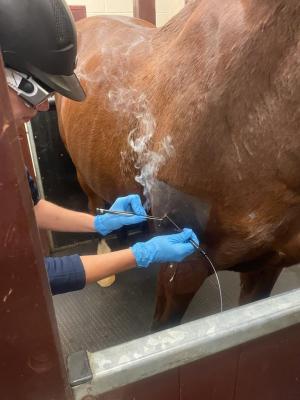Equine Therapy Programs: Transforming Lives One Ride at once
Equine Therapy Programs: Transforming Lives One Ride at once
Blog Article
Laser Therapy in Equine Therapy: A Modern Method to Improving Horse Health And Wellness
Laser therapy has actually become a pivotal strategy in equine treatment, making use of concentrated light power to promote cellular fixing and speed up recuperation from a range of ailments. This non-invasive technique is particularly reliable in managing bone and joint injuries, wounds, and inflammatory problems, significantly improving overall equine health. By promoting mitochondrial activity and increasing ATP manufacturing, laser therapy not just enhances circulation however likewise offers substantial discomfort alleviation. As this ingenious treatment remains to get grip, it opens up interesting opportunities for resolving persistent problems like joint inflammation and hoof issues, signifying a transformative shift in veterinary care. What makes this method especially compelling?
Understanding Laser Therapy
Laser treatment, a non-invasive treatment method, has gotten substantial traction in equine medicine due to its efficacy in promoting recovery and pain relief. This advanced therapeutic strategy makes use of focused light energy to pass through tissues, fostering mobile repair and regeneration. The underlying mechanism involves the stimulation of mobile mitochondria, resulting in enhanced manufacturing of adenosine triphosphate (ATP), the energy currency of cells. Boosted ATP degrees quicken cells repair work processes and reduce swelling, making laser therapy particularly reliable for treating musculoskeletal injuries, injuries, and other inflammatory conditions in horses.
There are numerous sorts of lasers made use of in equine treatment, each with details wavelengths and power results customized to various therapeutic demands. Low-level laser therapy (LLLT), additionally referred to as cold laser treatment, employs reduced power levels to stimulate cell function without creating thermal damages. High-intensity laser therapy (HILT), on the other hand, uses greater power levels to attain deeper cells penetration and more substantial restorative results.
Veterinarians utilize different laser devices and methods depending on the condition being dealt with and the desired depth of cells penetration. Proper training and competence are important for ensuring the risk-free and reliable application of laser therapy, thus optimizing its therapeutic capacity while lessening threats.
Advantages for Equine Health
With a solid understanding of just how laser treatment functions, it is crucial to explore its numerous advantages for equine wellness. By promoting cellular function, laser treatment advertises faster wound healing and aids in the regrowth of broken cells.
In addition, laser treatment has actually been revealed to improve blood circulation, thereby enhancing blood circulation to influenced locations. Enhanced circulation makes sure that important nutrients and oxygen are delivered more efficiently, facilitating the healing process. Furthermore, laser treatment's anti-inflammatory results aid in reducing swelling and discomfort, which is important for the general well-being of the steed.
Discomfort monitoring is an additional substantial benefit. By releasing endorphins and obstructing discomfort signals, laser therapy provides reliable, non-invasive alleviation from both severe and persistent discomfort. This can add to boosted wheelchair and lifestyle for the pet.
Lastly, laser treatment is a non-invasive therapy choice, decreasing the risk of difficulties connected with even more invasive treatments. Its versatility and efficiency make it a vital tool in contemporary horse vet medication.
Common Problems Dealt With

Another widespread condition treated with laser treatment is arthritis. Equines suffering from both severe and persistent joint inflammation benefit from the anti-inflammatory effects of laser treatment, which assists to alleviate pain and improve joint function. Furthermore, laser treatment is used in the management of wounds. Whether dealing with medical incisions or terrible injuries, the technique advertises quicker cells repair service and lowers the risk of infection.
Horse breathing problems, such as persistent airway blockage (RAO), also react favorably to laser treatment. Laser therapy is helpful in treating unguis problems, consisting of laminitis and abscesses.
Treatment and Security
Implementing laser treatment in equine therapy includes a meticulous procedure to ensure both effectiveness and safety. Equine Therapy. The process starts with an extensive veterinary analysis to determine the viability of laser treatment for the equine's details condition. When regarded appropriate, the treatment location is prepared by cleansing and, if required, clipping the like it hair to improve laser infiltration
The specialist needs to select the appropriate kind of laser, commonly a low-level laser (LLLT) or a high-power laser (HPL), depending on the condition being dealt with. The laser tool is then calibrated to the proper wavelength, power, and period settings. During the application, the professional relocates the laser over the targeted area in an organized fashion, ensuring constant and also exposure.
Security methods are strictly adhered to, including the use of safety eyewear for both the expert and the equine. Furthermore, it is critical to keep track of the equine for any signs of discomfort or negative responses throughout the treatment. Post-treatment, the steed is often given a duration of remainder to permit the healing results to manifest.

Future of Horse Laser Treatment
As innovations in veterinary medication continue to unravel, the future of equine laser therapy holds substantial promise. Arising technologies and much deeper scientific insights are established to refine and increase the applications of laser therapy for equines.
Moreover, continuous study into the molecular and mobile mechanisms of laser therapy will likely generate optimized procedures tailored to certain problems, improving efficiency and reducing treatment times. Individualized treatment plans based upon hereditary and biochemical markers might come true, making certain that each horse gets one of the most appropriate and efficient care.
Moreover, governing advancements and standardization of procedures will certainly boost the integrity and reliability of laser therapy in equine practice. Equine Therapy. click this site As these advancements proceed to emerge, equine laser therapy is poised to end up being a crucial part of vet care, offering enhanced healing and enhanced high quality of life for equines around the world
Conclusion

Report this page